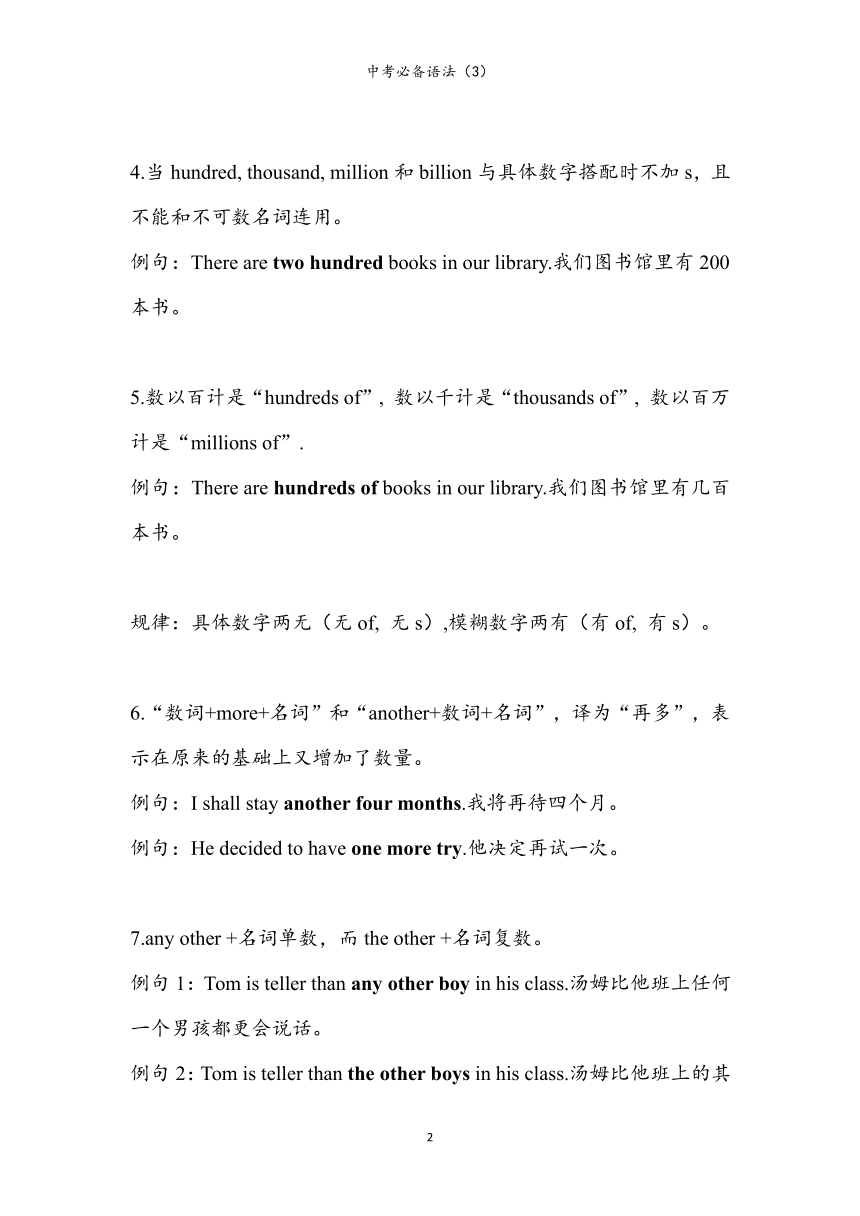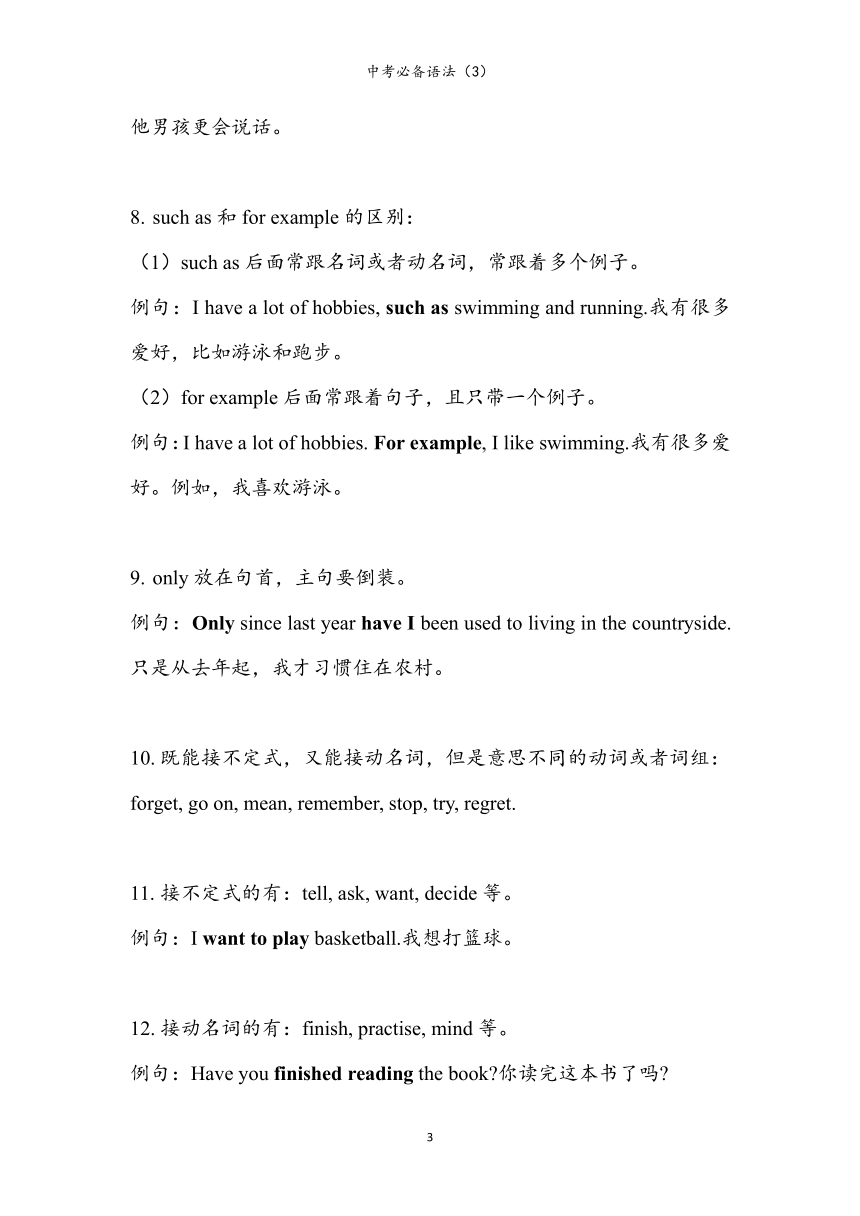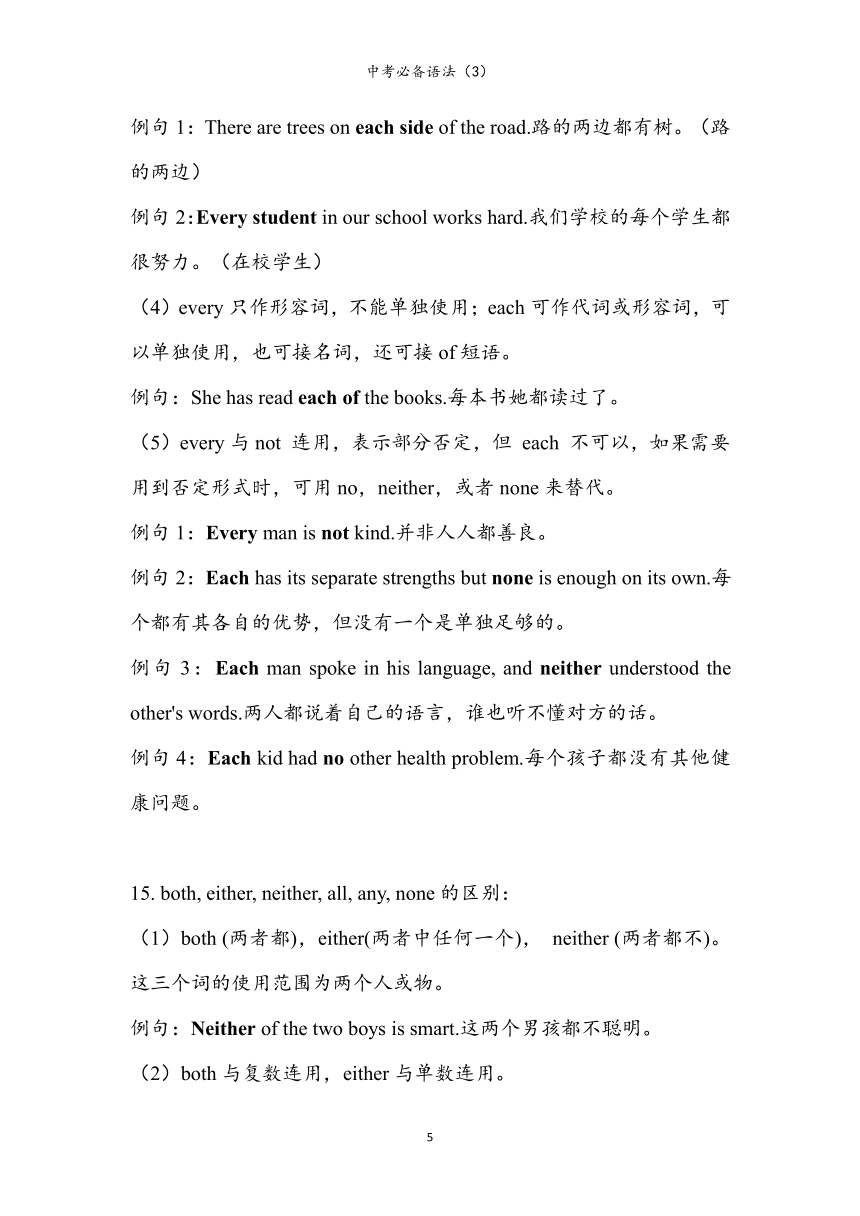沪教牛津版中考英语必备语法梳理(3)
图片预览





文档简介
中考必备语法(3)
四、基础语法汇总:
1.look up的宾格是人称代词时,代词需用宾格,且必须放在look和up中间,如look them up.
2.Look for, look up等短语后面接宾语时:
如果是代词,必须放在中间。
例句:Look at this word, can you help me look it up in the dictionary 看这个词,你能帮我查字典吗
如果后面接名词,可以把该名词放在中间也可以放在后面。
例句1:Can you help me look the word up in the dictionary 你能帮我在字典里查一下这个词吗
例句2:Can you help me look up the word in the dictionary 你能帮我在字典里查这个词吗
3.include和including的区别:
(1)include是动词,译为“包含;包括”
例句:The cat family includes lions and tigers.猫科动物包括狮子和老虎。
(2)including是介词,译为“包括...在内”,用于列举的事物之前,常接在逗号后面。
例句:Many middle school students like Journey to the West, including me.许多中学生喜欢《西游记》,包括我在内。
4.当hundred, thousand, million和billion与具体数字搭配时不加s,且不能和不可数名词连用。
例句:There are two hundred books in our library.我们图书馆里有200本书。
5.数以百计是“hundreds of”, 数以千计是“thousands of”, 数以百万计是“millions of”.
例句:There are hundreds of books in our library.我们图书馆里有几百本书。
规律:具体数字两无(无of, 无s),模糊数字两有(有of, 有s)。
6.“数词+more+名词”和“another+数词+名词”,译为“再多”,表示在原来的基础上又增加了数量。
例句:I shall stay another four months.我将再待四个月。
例句:He decided to have one more try.他决定再试一次。
7.any other +名词单数,而the other +名词复数。
例句1:Tom is teller than any other boy in his class.汤姆比他班上任何一个男孩都更会说话。
例句2:Tom is teller than the other boys in his class.汤姆比他班上的其他男孩更会说话。
such as和for example的区别:
such as后面常跟名词或者动名词,常跟着多个例子。
例句:I have a lot of hobbies, such as swimming and running.我有很多爱好,比如游泳和跑步。
for example后面常跟着句子,且只带一个例子。
例句:I have a lot of hobbies. For example, I like swimming.我有很多爱好。例如,我喜欢游泳。
only放在句首,主句要倒装。
例句:Only since last year have I been used to living in the countryside.只是从去年起,我才习惯住在农村。
既能接不定式,又能接动名词,但是意思不同的动词或者词组:forget, go on, mean, remember, stop, try, regret.
接不定式的有:tell, ask, want, decide等。
例句:I want to play basketball.我想打篮球。
接动名词的有:finish, practise, mind等。
例句:Have you finished reading the book 你读完这本书了吗
How soon和how far的区别:
(1)How soon译为“过多久”,一般用在将来时中,通常用“in+一段时间”回答。
例句:——How soon will the invitation be sent to our guests 邀请函什么时候能寄给我们的客人
——In two days.两天后。
(2)How long译为“多长时间”,提问时间段,通常用“for+一段时间”回答。
例句:——How long have they studied English 他们学英语多久了
——They have studied English for two years.他们已经学了两年英语了。
every和each的区别:
(1)every译为“(与单数名词连用,强调整体)每一个,每个”;each译为“(两个或两个以上的人或物中,强调个体)各自,各个,每个”。
(2)every可以与almost, nearly和数词等连用,而each不可以。
例句:Almost every student has read that newspaper.几乎每个学生都读过那份报纸。
(3)every 指三个以上的人或物(包含三个)的“每个”,each指两个以上的人或物 (包含两个)的“每个”。
例句1:There are trees on each side of the road.路的两边都有树。(路的两边)
例句2:Every student in our school works hard.我们学校的每个学生都很努力。(在校学生)
(4)every 只作形容词,不能单独使用;each可作代词或形容词,可以单独使用,也可接名词,还可接of短语。
例句:She has read each of the books.每本书她都读过了。
(5)every 与not 连用,表示部分否定,但 each 不可以,如果需要用到否定形式时,可用no,neither,或者none来替代。
例句1:Every man is not kind.并非人人都善良。
例句2:Each has its separate strengths but none is enough on its own.每个都有其各自的优势,但没有一个是单独足够的。
例句3:Each man spoke in his language, and neither understood the other's words.两人都说着自己的语言,谁也听不懂对方的话。
例句4:Each kid had no other health problem.每个孩子都没有其他健康问题。
both, either, neither, all, any, none的区别:
both (两者都),either(两者中任何一个), neither (两者都不)。这三个词的使用范围为两个人或物。
例句:Neither of the two boys is smart.这两个男孩都不聪明。
both与复数连用,either与单数连用。
例句1:There are flowers on both sides of the street.街道的两边都有花。(两岸)
例句2:There are flowers on either side of the street.街道的两边都有花。(岸的两边)
all (所有的,全部的人或物),any (任何一个), none (都不)。 这三个词的使用范围为三者以上。
例句1:All the flowers are gone.所有的花都没了。
例句2:I don't like any of the flowers.这些花我都不喜欢。
例句3:I like none of the flowers.这些花我都不喜欢。
all与none用法一样。跟单数名词,用单数动词;跟复数名词,用复数动词。
例句1:All of the students are there.所有的学生都在那里。
例句2:All of the milk is there.所有的牛奶都在那里。
else要放在不定代词后,所有格加在词组的最后面。
例句:Put it down. You mustn’t read anyone else’ s letter.把它放下。你不能看别人的信。
challenge的使用:
(1)短语challenge sb. to sth.向某人挑战某事
例句:They challenged us to a football match last week.上周他们向我们发起足球比赛的挑战。
(2)challenge常与介词to连用,引出挑战的对象。
例句:The chairwoman is up against the greatest challenge to her position.女主席正面临职位上的最大挑战。
the rest of和the rest的区别:
the rest of译为“...的剩余部分”。当of后跟不可数名词,谓语动词用三单形式。但of后跟可数名词复数,谓语动词用非三单形式。
例句1:The rest of money is mine.剩下的钱是我的。
例句2:The rest of apples belong to them.剩下的苹果是属于他们的。
the rest作代词时,当指代的名词是不可数名词,谓语动词用单数。当指代的名词是可数名词复数,谓语动词用复数。
例句1:Some members in his team would like to go swimming, the rest want to play football.他的一些队员想去游泳,其余的想踢足球。
例句2:Most water was sent to water the flowers and the rest was used to drink.大部分水被用来浇花,其余的被用来喝。
instead的用法:
instead of sb.译为“代替某人”
例句:She took the chance instead of Mike.她替迈克冒了这个险。
instead of doing sth.译为“代替做某事”
例句:He just stood instead of sitting down.他只是站着,没有坐下。
instead of sth.译为“代替某事”
例句:I prefer to choose A instead of B.我宁愿选A而不选B。
instead可置于句首,但是要用逗号与主句隔开;也可以放置句末,不需要逗号。
例句1:He didn’t drive to work. Instead, he rode his bike to the company.他没有开车去上班。相反,他骑自行车去了公司。
例句2:I am tired, I may stay at home instead.我累了,我可能会呆在家里。
way的使用:
on the way to+地点,或者on one’s way to+地点。但是当地点是home, here, there时,要省略to。
例句1:On her way to school, she met her Chinese teacher.在上学的路上,她遇到了她的语文老师。
例句2:On his way home, he helped a lost girl find her father.在回家的路上,他帮助一个走失的女孩找到了她的父亲。
by the way译为“顺便提及下”,in a way译为“在一定程度上”, in the way译为“挡路”。
例句1:By the way, what time is it 顺便问一下,现在几点了
例句2:In a way, your answer is right.在某种程度上,你的答案是对的。
例句3:A car is in the way.一辆汽车挡住了路。
a way to do sth.= a way of doing sth.译为“做某事的方法”
例句:Everyone has his own way of doing things .每个人都有自己的做事方式。
in a/an + adj. way译为“以一种...的方法”
例句:She used a useful way to solve the problem.她用一种有用的方法解决了这个问题。
in this/ that way译为“用这种/那种方法”
例句1:In this way, you can work out the maths problem easily.用这种方法,你可以很容易地解出这道数学题。
例句2:It is foolish to end your life in that way.以那种方式结束生命是愚蠢的。
in some/many ways译为“在一些/许多方面”
例句:Economic conditions are significant in many ways.经济状况在很多方面都很重要。
“不再”的英文表达
“数量上或者程度上”不再:not...any more = no more
例句:The boy didn’t cry any more = The boy no more cried.男孩不再哭了。
“时间上或者距离上”不再:not...any longer = no longer
例句:She doesn’t live here any more = She no longer lives here.她不再住在这里了。
not不可以单独使用,要与情态动词,助动词或者be动词连用。
例句:He can’t be serious.他不可能认真。
时间段+later译为“...之后”
例句:One year later, he returned home.一年后,他回到了家乡。
at the age of +数字, 译为“在几岁时”
例句:At the age of 16, he bought a new car.16岁时,他买了一辆新车。
年代表达是in the整十年代的复数形式。
例句:In the 1940s, the first computers were bigger than cars.在20世纪40年代,第一台电脑比汽车还大。
基数词(大于等于3)+times表示倍数。
例句:The meeting room is three times as big as his living room.会议室是他客厅的三倍大。
in one’s+基数词复数形式表示“在某人...岁时”。
例句:He began to work in his twenties. 他二十多岁开始工作。
基数词变成序数词:
(1)第一st, 第二nd, 第三rd, 第其它th.
(2)第八减t,第九减e, 第五用f替换ve
(3)遇到整十,ty变成tie
(4)遇到第几十几,变个位就可以
分数和百分数的表达:
分子用基数词,分母用序数词。分子大于1时,分母要加s.如two thirds
小数的写法:小数点前后的数都用基数词,小数点写作point.如zero point three night
百分数的写法:在数词后加percent的单数形式。如fifteen percent
基数词+序数词,谓语的单复数由该分数所接的名词决定。
例句:Two thirds of the water on the earth is sea water.地球上三分之二的水是海水。
数量词:
an amount of+不可数名词,译为“许多,大量”
例句:An amount of patience is required to deal with such problems.处理这样的问题需要很大的耐心。
the amount of+不可数名词/可数名词复数,译为“...的数量”
例句:The amount of the people present reaches 300.出席的人数达到300人。
the number of+可数名词复数,译为“...的数量”,谓语动词用单数。
例句:The number of the apples is 40.苹果的数量是40个。
a number of+可数名词复数,译为“许多,大量”,谓语动词用复数。
例句:A number of students were in the classroom.教室里有许多学生。
mountains of+可数名词/不可数名词,译为“许多,大量”
例句:Mountains of debt will have to be reduced.堆积如山的债务必须减少。
五、重点语法汇总:
1.as...as的用法:
(1)同级比较:be动词+ as + adj.的原级 + as 或者行为动词+ as + adv.的原级+ as.
例句1:He is as rich as her.他和她一样富有。
例句2:He runs as fast as her.他跑得和她一样快。
(2)同级比较的否定形式:not/ as + adj./adv.的原级+as
例句:This story is not as interesting as that one.这个故事不如那个故事有趣。
(3)数量的比较:(not) as many +可数名词复数+ as 或者 (not) as much +不可数名词+ as.
例句1:There are not as many restaurants as there were.餐馆没有以前那么多了。
例句2:He can get twice as much salary as mine.他的薪水是我的两倍。
复合不定代词(复合不定代词是由some-,any-,no-,every-加上-one,-body,-thing等所组成的不定代词)的用法:
复合不定代词+形容词
例句:I have something important to say.我有重要的事情要说。
复合不定代词+to do
例句:Do you have anything to say?你有什么要说的吗
复合不定代词作主语时,谓语用单数。
例句:Something beautiful costs a lot of money.漂亮的东西要花很多钱。
肯定句常用something,否定句和疑问句常用anything.但是表示希望得到肯定回答或者表示邀请的疑问句中,用something.
例句:Would you like something to eat 你想吃点什么吗
复合不定代词的全否定:not anything
例句:There is not anything in the room.房间里什么也没有。
复合不定代词的部分否定:not everybody
例句:Not everybody likes his pictures.不是每个人都喜欢他的画。
if引导的条件状语从句:
主将从现:主句用一般将来时,从句用一般现在时。
例句:If he wins the game tomorrow, he will get a gold medal.如果他赢得明天的比赛,他将获得金牌。
主情从现:主语含有情态动词,从句用一般现在时。
例句:If you finish your homework on time, you can get any prize you want. 如果你按时完成作业,你可以得到任何你想要的奖品。
主祈从现:主句是祈使句,从句用一般现在时。
例句:Print the photo if you like it.如果你喜欢,就把照片打印出来。
主现从现:描述客观真理,主句和从句都用一般现在时。
例句:If fish leave water, they die.如果鱼离开水,它们就会死亡。
4.时间介词:
in用在年、月、季节等前。留意固定搭配:In the morning/ afternoon/ evening.
例句1:Mike was born in 2001.迈克出生于2001年。
例句2:People always plant trees in Spring.人们总是在春天种树。
例句3:The Spring Festival is always in January or February.春节总是在一月或二月。
on用在星期或者具体日期。但是具体到某天上午/下午/晚上用on,如on a cold afternoon.
例句1:Christmas is always on December 25th.圣诞节总是在12月25日。
例句2:He often plays basketball on Sunday.他经常在星期天打篮球。
at用在具体时间点。固定搭配:at night, at noon等。
例句:The meeting will begin at 2:00 am.会议将于凌晨两点开始。
四、基础语法汇总:
1.look up的宾格是人称代词时,代词需用宾格,且必须放在look和up中间,如look them up.
2.Look for, look up等短语后面接宾语时:
如果是代词,必须放在中间。
例句:Look at this word, can you help me look it up in the dictionary 看这个词,你能帮我查字典吗
如果后面接名词,可以把该名词放在中间也可以放在后面。
例句1:Can you help me look the word up in the dictionary 你能帮我在字典里查一下这个词吗
例句2:Can you help me look up the word in the dictionary 你能帮我在字典里查这个词吗
3.include和including的区别:
(1)include是动词,译为“包含;包括”
例句:The cat family includes lions and tigers.猫科动物包括狮子和老虎。
(2)including是介词,译为“包括...在内”,用于列举的事物之前,常接在逗号后面。
例句:Many middle school students like Journey to the West, including me.许多中学生喜欢《西游记》,包括我在内。
4.当hundred, thousand, million和billion与具体数字搭配时不加s,且不能和不可数名词连用。
例句:There are two hundred books in our library.我们图书馆里有200本书。
5.数以百计是“hundreds of”, 数以千计是“thousands of”, 数以百万计是“millions of”.
例句:There are hundreds of books in our library.我们图书馆里有几百本书。
规律:具体数字两无(无of, 无s),模糊数字两有(有of, 有s)。
6.“数词+more+名词”和“another+数词+名词”,译为“再多”,表示在原来的基础上又增加了数量。
例句:I shall stay another four months.我将再待四个月。
例句:He decided to have one more try.他决定再试一次。
7.any other +名词单数,而the other +名词复数。
例句1:Tom is teller than any other boy in his class.汤姆比他班上任何一个男孩都更会说话。
例句2:Tom is teller than the other boys in his class.汤姆比他班上的其他男孩更会说话。
such as和for example的区别:
such as后面常跟名词或者动名词,常跟着多个例子。
例句:I have a lot of hobbies, such as swimming and running.我有很多爱好,比如游泳和跑步。
for example后面常跟着句子,且只带一个例子。
例句:I have a lot of hobbies. For example, I like swimming.我有很多爱好。例如,我喜欢游泳。
only放在句首,主句要倒装。
例句:Only since last year have I been used to living in the countryside.只是从去年起,我才习惯住在农村。
既能接不定式,又能接动名词,但是意思不同的动词或者词组:forget, go on, mean, remember, stop, try, regret.
接不定式的有:tell, ask, want, decide等。
例句:I want to play basketball.我想打篮球。
接动名词的有:finish, practise, mind等。
例句:Have you finished reading the book 你读完这本书了吗
How soon和how far的区别:
(1)How soon译为“过多久”,一般用在将来时中,通常用“in+一段时间”回答。
例句:——How soon will the invitation be sent to our guests 邀请函什么时候能寄给我们的客人
——In two days.两天后。
(2)How long译为“多长时间”,提问时间段,通常用“for+一段时间”回答。
例句:——How long have they studied English 他们学英语多久了
——They have studied English for two years.他们已经学了两年英语了。
every和each的区别:
(1)every译为“(与单数名词连用,强调整体)每一个,每个”;each译为“(两个或两个以上的人或物中,强调个体)各自,各个,每个”。
(2)every可以与almost, nearly和数词等连用,而each不可以。
例句:Almost every student has read that newspaper.几乎每个学生都读过那份报纸。
(3)every 指三个以上的人或物(包含三个)的“每个”,each指两个以上的人或物 (包含两个)的“每个”。
例句1:There are trees on each side of the road.路的两边都有树。(路的两边)
例句2:Every student in our school works hard.我们学校的每个学生都很努力。(在校学生)
(4)every 只作形容词,不能单独使用;each可作代词或形容词,可以单独使用,也可接名词,还可接of短语。
例句:She has read each of the books.每本书她都读过了。
(5)every 与not 连用,表示部分否定,但 each 不可以,如果需要用到否定形式时,可用no,neither,或者none来替代。
例句1:Every man is not kind.并非人人都善良。
例句2:Each has its separate strengths but none is enough on its own.每个都有其各自的优势,但没有一个是单独足够的。
例句3:Each man spoke in his language, and neither understood the other's words.两人都说着自己的语言,谁也听不懂对方的话。
例句4:Each kid had no other health problem.每个孩子都没有其他健康问题。
both, either, neither, all, any, none的区别:
both (两者都),either(两者中任何一个), neither (两者都不)。这三个词的使用范围为两个人或物。
例句:Neither of the two boys is smart.这两个男孩都不聪明。
both与复数连用,either与单数连用。
例句1:There are flowers on both sides of the street.街道的两边都有花。(两岸)
例句2:There are flowers on either side of the street.街道的两边都有花。(岸的两边)
all (所有的,全部的人或物),any (任何一个), none (都不)。 这三个词的使用范围为三者以上。
例句1:All the flowers are gone.所有的花都没了。
例句2:I don't like any of the flowers.这些花我都不喜欢。
例句3:I like none of the flowers.这些花我都不喜欢。
all与none用法一样。跟单数名词,用单数动词;跟复数名词,用复数动词。
例句1:All of the students are there.所有的学生都在那里。
例句2:All of the milk is there.所有的牛奶都在那里。
else要放在不定代词后,所有格加在词组的最后面。
例句:Put it down. You mustn’t read anyone else’ s letter.把它放下。你不能看别人的信。
challenge的使用:
(1)短语challenge sb. to sth.向某人挑战某事
例句:They challenged us to a football match last week.上周他们向我们发起足球比赛的挑战。
(2)challenge常与介词to连用,引出挑战的对象。
例句:The chairwoman is up against the greatest challenge to her position.女主席正面临职位上的最大挑战。
the rest of和the rest的区别:
the rest of译为“...的剩余部分”。当of后跟不可数名词,谓语动词用三单形式。但of后跟可数名词复数,谓语动词用非三单形式。
例句1:The rest of money is mine.剩下的钱是我的。
例句2:The rest of apples belong to them.剩下的苹果是属于他们的。
the rest作代词时,当指代的名词是不可数名词,谓语动词用单数。当指代的名词是可数名词复数,谓语动词用复数。
例句1:Some members in his team would like to go swimming, the rest want to play football.他的一些队员想去游泳,其余的想踢足球。
例句2:Most water was sent to water the flowers and the rest was used to drink.大部分水被用来浇花,其余的被用来喝。
instead的用法:
instead of sb.译为“代替某人”
例句:She took the chance instead of Mike.她替迈克冒了这个险。
instead of doing sth.译为“代替做某事”
例句:He just stood instead of sitting down.他只是站着,没有坐下。
instead of sth.译为“代替某事”
例句:I prefer to choose A instead of B.我宁愿选A而不选B。
instead可置于句首,但是要用逗号与主句隔开;也可以放置句末,不需要逗号。
例句1:He didn’t drive to work. Instead, he rode his bike to the company.他没有开车去上班。相反,他骑自行车去了公司。
例句2:I am tired, I may stay at home instead.我累了,我可能会呆在家里。
way的使用:
on the way to+地点,或者on one’s way to+地点。但是当地点是home, here, there时,要省略to。
例句1:On her way to school, she met her Chinese teacher.在上学的路上,她遇到了她的语文老师。
例句2:On his way home, he helped a lost girl find her father.在回家的路上,他帮助一个走失的女孩找到了她的父亲。
by the way译为“顺便提及下”,in a way译为“在一定程度上”, in the way译为“挡路”。
例句1:By the way, what time is it 顺便问一下,现在几点了
例句2:In a way, your answer is right.在某种程度上,你的答案是对的。
例句3:A car is in the way.一辆汽车挡住了路。
a way to do sth.= a way of doing sth.译为“做某事的方法”
例句:Everyone has his own way of doing things .每个人都有自己的做事方式。
in a/an + adj. way译为“以一种...的方法”
例句:She used a useful way to solve the problem.她用一种有用的方法解决了这个问题。
in this/ that way译为“用这种/那种方法”
例句1:In this way, you can work out the maths problem easily.用这种方法,你可以很容易地解出这道数学题。
例句2:It is foolish to end your life in that way.以那种方式结束生命是愚蠢的。
in some/many ways译为“在一些/许多方面”
例句:Economic conditions are significant in many ways.经济状况在很多方面都很重要。
“不再”的英文表达
“数量上或者程度上”不再:not...any more = no more
例句:The boy didn’t cry any more = The boy no more cried.男孩不再哭了。
“时间上或者距离上”不再:not...any longer = no longer
例句:She doesn’t live here any more = She no longer lives here.她不再住在这里了。
not不可以单独使用,要与情态动词,助动词或者be动词连用。
例句:He can’t be serious.他不可能认真。
时间段+later译为“...之后”
例句:One year later, he returned home.一年后,他回到了家乡。
at the age of +数字, 译为“在几岁时”
例句:At the age of 16, he bought a new car.16岁时,他买了一辆新车。
年代表达是in the整十年代的复数形式。
例句:In the 1940s, the first computers were bigger than cars.在20世纪40年代,第一台电脑比汽车还大。
基数词(大于等于3)+times表示倍数。
例句:The meeting room is three times as big as his living room.会议室是他客厅的三倍大。
in one’s+基数词复数形式表示“在某人...岁时”。
例句:He began to work in his twenties. 他二十多岁开始工作。
基数词变成序数词:
(1)第一st, 第二nd, 第三rd, 第其它th.
(2)第八减t,第九减e, 第五用f替换ve
(3)遇到整十,ty变成tie
(4)遇到第几十几,变个位就可以
分数和百分数的表达:
分子用基数词,分母用序数词。分子大于1时,分母要加s.如two thirds
小数的写法:小数点前后的数都用基数词,小数点写作point.如zero point three night
百分数的写法:在数词后加percent的单数形式。如fifteen percent
基数词+序数词,谓语的单复数由该分数所接的名词决定。
例句:Two thirds of the water on the earth is sea water.地球上三分之二的水是海水。
数量词:
an amount of+不可数名词,译为“许多,大量”
例句:An amount of patience is required to deal with such problems.处理这样的问题需要很大的耐心。
the amount of+不可数名词/可数名词复数,译为“...的数量”
例句:The amount of the people present reaches 300.出席的人数达到300人。
the number of+可数名词复数,译为“...的数量”,谓语动词用单数。
例句:The number of the apples is 40.苹果的数量是40个。
a number of+可数名词复数,译为“许多,大量”,谓语动词用复数。
例句:A number of students were in the classroom.教室里有许多学生。
mountains of+可数名词/不可数名词,译为“许多,大量”
例句:Mountains of debt will have to be reduced.堆积如山的债务必须减少。
五、重点语法汇总:
1.as...as的用法:
(1)同级比较:be动词+ as + adj.的原级 + as 或者行为动词+ as + adv.的原级+ as.
例句1:He is as rich as her.他和她一样富有。
例句2:He runs as fast as her.他跑得和她一样快。
(2)同级比较的否定形式:not/ as + adj./adv.的原级+as
例句:This story is not as interesting as that one.这个故事不如那个故事有趣。
(3)数量的比较:(not) as many +可数名词复数+ as 或者 (not) as much +不可数名词+ as.
例句1:There are not as many restaurants as there were.餐馆没有以前那么多了。
例句2:He can get twice as much salary as mine.他的薪水是我的两倍。
复合不定代词(复合不定代词是由some-,any-,no-,every-加上-one,-body,-thing等所组成的不定代词)的用法:
复合不定代词+形容词
例句:I have something important to say.我有重要的事情要说。
复合不定代词+to do
例句:Do you have anything to say?你有什么要说的吗
复合不定代词作主语时,谓语用单数。
例句:Something beautiful costs a lot of money.漂亮的东西要花很多钱。
肯定句常用something,否定句和疑问句常用anything.但是表示希望得到肯定回答或者表示邀请的疑问句中,用something.
例句:Would you like something to eat 你想吃点什么吗
复合不定代词的全否定:not anything
例句:There is not anything in the room.房间里什么也没有。
复合不定代词的部分否定:not everybody
例句:Not everybody likes his pictures.不是每个人都喜欢他的画。
if引导的条件状语从句:
主将从现:主句用一般将来时,从句用一般现在时。
例句:If he wins the game tomorrow, he will get a gold medal.如果他赢得明天的比赛,他将获得金牌。
主情从现:主语含有情态动词,从句用一般现在时。
例句:If you finish your homework on time, you can get any prize you want. 如果你按时完成作业,你可以得到任何你想要的奖品。
主祈从现:主句是祈使句,从句用一般现在时。
例句:Print the photo if you like it.如果你喜欢,就把照片打印出来。
主现从现:描述客观真理,主句和从句都用一般现在时。
例句:If fish leave water, they die.如果鱼离开水,它们就会死亡。
4.时间介词:
in用在年、月、季节等前。留意固定搭配:In the morning/ afternoon/ evening.
例句1:Mike was born in 2001.迈克出生于2001年。
例句2:People always plant trees in Spring.人们总是在春天种树。
例句3:The Spring Festival is always in January or February.春节总是在一月或二月。
on用在星期或者具体日期。但是具体到某天上午/下午/晚上用on,如on a cold afternoon.
例句1:Christmas is always on December 25th.圣诞节总是在12月25日。
例句2:He often plays basketball on Sunday.他经常在星期天打篮球。
at用在具体时间点。固定搭配:at night, at noon等。
例句:The meeting will begin at 2:00 am.会议将于凌晨两点开始。
同课章节目录
- 词法
- 名词
- 动词和动词短语
- 动词语态
- 动词时态
- 助动词和情态动词
- 非谓语动词
- 冠词
- 代词
- 数词和量词
- 形容词副词及其比较等级
- 介词和介词短语
- 连词和感叹词
- 构词法
- 相似、相近词比较
- 句法
- 陈述句
- 一般疑问句和否定疑问句
- 特殊疑问句及选择疑问句
- 反意疑问句
- 存在句(There be句型)
- 宾语从句
- 定语从句
- 状语从句
- 主谓一致问题
- 简单句
- 并列句
- 复合句
- 主谓一致
- 主、表语从句
- 名词性从句
- 直接引语和间接引语
- 虚拟语气
- 感叹句
- 强调句
- 倒装句
- 祈使句
- 句子的成分
- 句子的分类
- 题型专区
- 单项选择部分
- 易错题
- 完形填空
- 阅读理解
- 词汇练习
- 听说训练
- 句型转换
- 补全对话
- 短文改错
- 翻译
- 书面表达
- 任务型阅读
- 语法填空
- 其他资料
